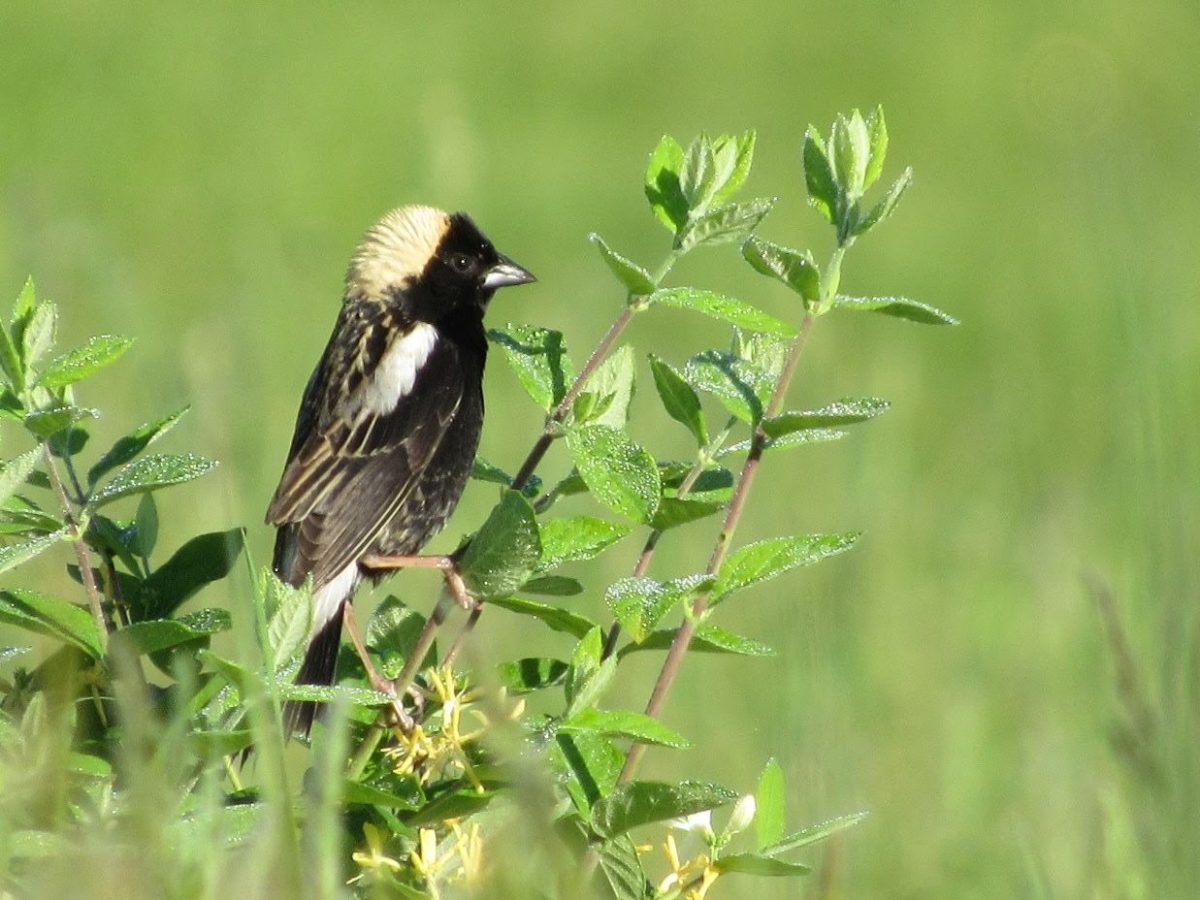In spite of everything we’re all trying to endure and overcome, still the days are getting longer and nature is showing familiar signs of renewal. Even a brief moment outside can deliver restorative distractions – an unfurling leaf, a bee on a blooming flower, or even just the sun shining higher in the sky and warmer on our faces with each passing week.
And if you’re lucky, you might even get out a greening meadow to watch and listen, and be rewarded with one of the spirit-lifting shows of the season, starring one of our most distinctive songbird species, the Bobolink.
Bobolinks arrive in our Finger Lakes region in the first half of May. Male Bobolinks fill our grasslands with their ebullient clanking song, conspicuously fighting over territories and vying for the attention of females. Adult males are quite distinctive in breeding plumage, with black faces, chests, and bellies contrasting with a white back and a straw-colored cap at the rear of the head. Roger Tory Peterson famously noted that they look as if they are wearing tuxedoes backward. Females, on the other hand, are subtly brown, with cryptic black stripes that help them disappear into the grass.
Bobolinks are both polygynous and polyandrous – that is, both males and females can have multiple mates within a breeding season. They nest on the ground against tall grasses or forbs, with clutches of three to seven eggs. Young hatch in June or July and are generally able to fly by late July.
By early September, Bobolinks stage in flocks in preparation for travel to wintering grounds in South America – a trip of over 6,000 miles, among the longest migrations of any North American songbird. During this epic journey, Bobolinks navigate by sensing the earth’s magnetic field, using iron oxide in bristles in their nasal cavities. They also orient themselves by stars in the night sky.
Before European settlement of North America, when most of our region was forested, Bobolinks likely had relatively modest populations confined to scattered floodplains and native prairie. Their populations expanded with the widespread clearing of land for agriculture, and probably peaked in the late 1800s and early 1900s.
Since that heyday, however, Bobolinks have been in steady decline. Widespread hunting of the birds for food and agricultural control took a heavy toll up until the passage of the Migratory Bird Treaty Act in 1918. Furthermore, for more than a century, agricultural land cover has been shrinking and becoming fragmented by suburban development and reversion to forest. According to the North American Breeding Bird Survey, the population of Bobolinks in the United States declined by 65 percent between 1966 and 2015. Long-term surveys have documented similar declines for other grassland birds of our region, including Upland Sandpipers, Short-eared Owls, Sedge Wrens, and Henslow’s Sparrows.
Bobolinks’ main remaining habitat in our region is in hayfields. Here too, they have faced persistent challenges. Farmers have been cutting their fields earlier and more frequently, because young hay has higher protein content, digestibility, and overall nutritional value. The longer the farmer waits to harvest, the coarser and thicker-stemmed the grasses will be. Late-harvested hay is considered acceptable feed only for horses, sheep, and beef cattle – but notably, not for dairy cows. Heavier grasses are also more difficult to dry and rake before baling. Meanwhile, for Bobolinks and other grassland-breeding birds, early mowing means the catastrophic loss of nests, eggs, and young birds not yet able to fly.
Thus the main regional focus for grassland bird conservation over the past two decades has been in providing farmers with incentives and guidance to delay mowing and to rotate fields so as to leave some acreage as grassland all summer. Most notably, the Landowner Incentive Program, developed by Audubon New York and implemented by the NYS Department of Environmental Conservation, has brought over 4,300 acres under conservation management for grassland birds since 2008.
The Land Trust too is doing its part to protect Bobolinks. At several of its properties – from the Houghton Land Preserve in Corning, to the new Summerland Farm Preserve in Caroline, to new lands recently acquired above Owasco Lake, and more – the Land Trust is sustaining grassland habitat through annual mowing, while ensuring that the timing is consistent with the needs of the breeding birds.
The travails of a Bobolink’s life might seem hardly relevant to our own lives in these times. But like other gifts of nature, the life of the Bobolink enriches us with perspective, and somehow maybe even moments of joy and hope. It affirms that each individual life, entwining with others to form life on the whole, is something wonderful and precious, something worth fighting for, and something never to take for granted.


